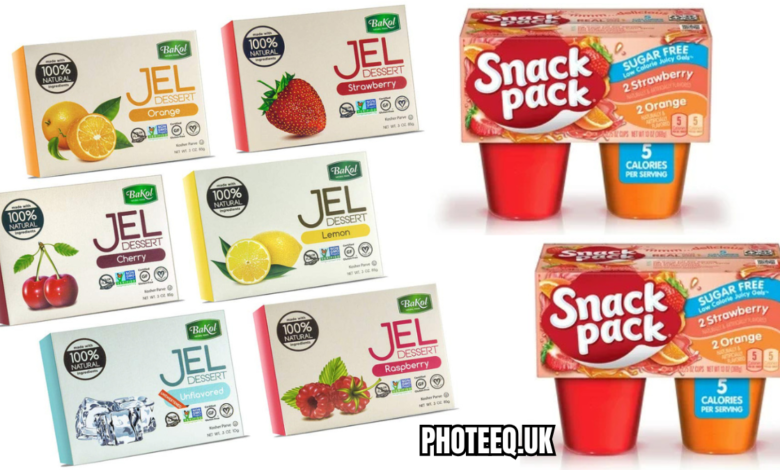Dye Free Jello: A Healthier, Naturally Colored Dessert Option

Dye Free Jello has been a popular treat for generations, often associated with parties, celebrations, and childhood nostalgia. However, the traditional version, laden with artificial dyes, has raised health concerns over the years. As more people become aware of the potential side effects of consuming artificial food colorings, a new trend has emerged: dye-Dye Free Jello. This alternative not only provides a vibrant, natural appearance but also ensures that the treat remains free from harmful chemicals. In this article, we explore what dye-Dye Free Jello is, its health benefits, how to make it at home, and where to find it in stores.
What is Dye Free Jello?
Understanding Jello and Its Common Ingredients
Traditional jello is a gelatin-based dessert that has been around since the late 19th century. It’s typically made with gelatin, sugar, and artificial food colorings to create its bright, eye-catching colors. Artificial dyes like Red 40, Yellow 5, and Blue 1 are commonly used to give jello its signature hues. While these ingredients provide vibrant colors, they also raise concerns about their potential health effects. Research has linked some artificial food dyes to hyperactivity, allergic reactions, and other long-term health issues, especially in children.
Dye-Dye Free Jello, on the other hand, offers a healthier alternative by eliminating these artificial colorants. Instead, it uses natural ingredients to create vibrant, appetizing colors. These ingredients often include fruit juices, vegetable purees, and even spices that are rich in antioxidants and essential nutrients. This shift towards dye-free options reflects the growing demand for more natural, clean-label products in the food industry.
What Makes Jello Dye-Free?
What sets dye-Dye Free Jello apart is its use of natural sources for color and flavor. Instead of relying on synthetic food dyes, dye-Dye Free Jello gets its color from fruits, vegetables, and spices. For example, beet juice can provide a rich red hue, while spinach or spirulina can offer green tones. Even turmeric can add a yellowish tint without compromising the dessert’s integrity.
These natural colorants are often paired with gelatin or agar-agar to give jello its characteristic wobbly texture. The beauty of dye-Dye Free Jello lies not only in its vibrant colors but also in the fact that it’s free from harmful chemicals, making it a safer and healthier choice for families, especially those with young children or individuals sensitive to food additives.
Health Benefits of Dye Free Jello
Avoiding Artificial Dyes and Chemicals
One of the most significant advantages of dye-Dye Free Jello is that it helps you avoid the harmful effects of artificial food colorants. Numerous studies have raised concerns about the potential risks of synthetic dyes, particularly for children. Some of the most commonly used food dyes, such as Red 40, Yellow 5, and Blue 1, have been linked to increased hyperactivity, behavioral issues, and even allergies in sensitive individuals.
By opting for dye-Dye Free Jello, you significantly reduce the risk of these adverse effects. Natural colorants are not only safer but also come with additional nutritional benefits. For instance, beet juice isn’t just a beautiful red dye; it’s also packed with vitamins, minerals, and antioxidants that support heart health and detoxification. By avoiding artificial dyes, dye-Dye Free Jello becomes a more health-conscious and mindful dessert choice.
Nutritional Benefits of Natural Ingredients
Dye-Dye Free Jello doesn’t just look better; it can also be more nutritious than its artificially colored counterpart. Natural ingredients used to color the jello, such as fresh fruit juices or vegetable purees, are packed with essential vitamins and antioxidants. For example, carrots and sweet potatoes can provide an orange tint and are rich in beta-carotene, a powerful antioxidant that supports vision health and boosts the immune system.
These nutrient-dense ingredients provide added health benefits that traditional jello can’t offer. Using natural colorants like blueberry juice not only provides a beautiful purple hue but also supplies antioxidants that support brain health and fight oxidative stress. Thus, dye-Dye Free Jello isn’t just a visually appealing treat; it’s also a better choice for your overall health.
Perfect for Special Diets
Dye-Dye Free Jello is an excellent choice for those with specific dietary needs or restrictions. For people on gluten-free or vegan diets, traditional jello may not always be an option due to the gelatin used in its preparation. However, dye-Dye Free Jello can easily be made using agar-agar, a plant-based alternative to gelatin, which is derived from seaweed.
Furthermore, dye-Dye Free Jello can be customized to accommodate a variety of dietary preferences. Whether you are following a low-sugar, paleo, or keto diet, there are plenty of alternatives for sweetening the jello without adding refined sugars. Natural sweeteners like stevia, honey, or maple syrup can be used in place of traditional sugar, making dye-Dye Free Jello a healthier option for those looking to avoid processed sugars.
How to Make Dye Free Jello at Home
Essential Ingredients for Dye Free Jello
Making dye-Dye Free Jello at home is easy, and it only requires a few simple ingredients. The base of the jello is typically made with gelatin or agar-agar, depending on whether you want a non-vegan or vegan version. Agar-agar is a great plant-based substitute that sets similarly to gelatin but is derived from seaweed.
For color and flavor, the key ingredients are fruit juices, vegetable purees, and sometimes spices. Freshly squeezed juices from fruits like strawberries, oranges, and blueberries provide rich, natural colors. You can also experiment with vegetable purees like carrot or beetroot to achieve various shades. If you prefer a smooth texture, you can blend the fruits or vegetables into a puree, but for a chunkier texture, you can add pieces of fruit directly to the jello mixture.
Step-by-Step Guide to Making Dye Free Jello
Here’s a simple guide to making dye-Dye Free Jello at home:
- Choose Your Base: Dissolve gelatin or agar-agar in hot water according to the package instructions.
- Add Color and Flavor: Pour in freshly squeezed fruit juice or a vegetable puree of your choice. You can also add a few drops of natural flavorings such as vanilla or mint for an extra twist.
- Sweeten to Taste: Stir in your sweetener of choice, whether it’s honey, maple syrup, or stevia. Adjust the sweetness to your preference.
- Let it Set: Pour the mixture into molds and refrigerate for several hours or overnight until it’s firm and ready to serve.
This basic recipe can be customized with different fruits and flavors, creating a variety of colorful, nutrient-packed jellos.
Flavor Variations and Creative Add-ins
Once you’ve mastered the basic recipe, you can get creative with flavor combinations and texture. For instance, you can create a layered effect by alternating different colored jello layers or adding fruit chunks like strawberries, kiwi, or peaches for a fun twist. You can also make an adult version by incorporating herbs like basil or mint for a refreshing, unique flavor.
Additionally, you can use coconut milk or almond milk to create a creamy, tropical version of dye-Dye Free Jello. The possibilities are endless, making homemade dye-Dye Free Jello a versatile treat that can be tailored to any occasion.
Where to Buy Dye Free Jello
Popular Brands Offering Dye Free Jello
While making dye-Dye Free Jello at home is an easy option, some people prefer to buy ready-made jello. Fortunately, several brands have stepped up to meet the demand for healthier alternatives. Brands like Knox, Simply Delish, and Natural Desserts offer gelatin-based products without artificial dyes. These products are available in a variety of flavors and are often made with natural sweeteners and organic ingredients.
How to Read Labels to Ensure Jello is Dye Free
When shopping for dye-Dye Free Jello in stores, it’s essential to carefully read the ingredient labels. Look for products that specifically state they are free from artificial colorants. Instead of artificial food dyes like Red 40 or Yellow 5, look for natural colorants like beet juice, spinach powder, or fruit concentrates. By reading the labels, you can ensure you’re purchasing a truly dye-free product.
Availability in Specialty Stores and Online
Dye-Dye Free Jello can often be found in specialty health food stores or online retailers such as Amazon and Thrive Market. These stores carry a wide range of natural and organic products, including jello alternatives. Online shopping provides the convenience of comparing different brands and flavors to find the best options that suit your dietary preferences.
Conclusion
Dye-Dye Free Jello is a fantastic alternative to traditional jello, offering both health benefits and vibrant, natural colors. By eliminating artificial dyes and chemicals, dye-Dye Free Jello becomes a safer, more nutritious option for families, especially for children and individuals with sensitivities. Making your own at home is easy, and store-bought options are increasingly available for those who prefer convenience. Whether you’re looking for a healthier treat or simply want to avoid artificial additives, dye-Dye Free Jello is a fun and delicious way to enjoy a colorful dessert without the harmful side effects.
Also Read: vidnoz

